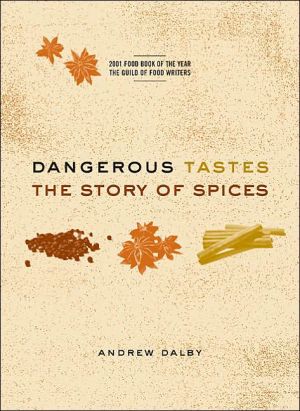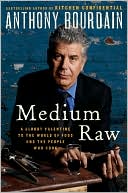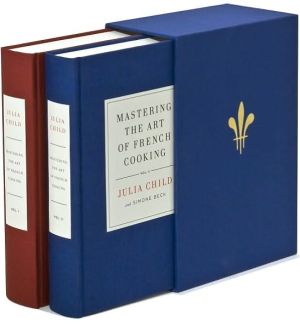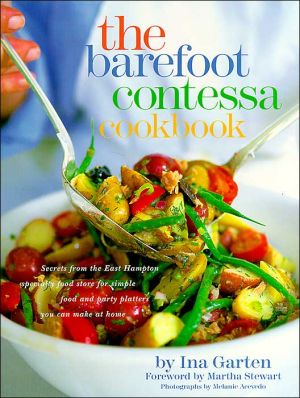Dangerous Tastes: The Story of Spices
Spices and aromatics—the powerful, pleasurable, sensual ingredients used in foods, drinks, scented oils, perfumes, cosmetics, and drugs—have long been some of the most sought-after substances in the course of human history.\ In various forms, spices have served as appetizers, digestives, antiseptics, therapeutics, tonics, and aphrodisiacs. Dangerous Tastes explores the captivating history of spices and aromatics: the fascination that they have aroused in us, and the roads and seaways by which...
Search in google:
"Delightful and complex. When Dalby blends the spices, the result is unique and irresistible."—Alan Davidson, author of The Oxford Companion to Food Ruminator Review Dalby follows the trade routes of spices and shows how a taste for the spicy is intermingled with the thrill and risk of traveling to unknown places. But the history of spices reveals a different kind of danger as well, since it shows our greed and brutality in exploiting others so that we may please our own palates.
\ Coriander or Cilantro\ \ The excavators of Frankhthi cave, near Portokheli in southern Greece, a site that was inhabited for many thousands of years in prehistoric times, found a tiny coriander fruit in a layer dated to the seventh millennium BC. If this was really something that the ancient cave-dwellers might have used—and not a red herring, dropped by one of the excavators—it makes coriander one of the very oldest spices in human use, quite as old as the ginger and sugar cane whose prehistory is traced above.\ Coriandrum sativum is certainly native to Greece and the eastern Mediterranean. It was familiar in Egypt in 1352 BC, for it is one of the foodstuffs found in Tutankhamen's tomb. As korianna its small dry fruits were listed in the Linear B tablets, in Greece around 1300 BC. Coriander played a major role in ancient Greek and in Roman cuisine, and has never ceased to be popular around the Mediterranean.\ Its popularity has spread far eastwards and westwards. We have already seen that it was introduced to India, probably at the time when the old Persian Empire stretched to the Indus valley. It advanced from there to south-east Asia, to the extent that coriander now seems a typical Indian spice and a typical south-east Asian herb. By way of Persia, coriander was also introduced to China. Later Chinese tradition suggested that this happened at the moment when Zhang Qian opened up the silk road, in fact that he personally brought coriander back with him in 125 BC. This is unlikely, not only historically—he had other things on his mind than coriander during his year-long imprisonment among the Huns and his lucky escape—but also because the earliest mention of coriander in Chinese texts is dated to the sixth century AD. In due course the Spaniards planted coriander in their American colonies: cilantro, as it is better known in America, is now one of the typical flavours of Mexican cuisine.\ It is an extremely versatile aromatic. Its leaves, garnishing meat dishes and stews, give an unmistakable pungent aroma—'soapy', perhaps, to those who cannot get the taste for it. Its spicy roots are specially useful in Thai cooking. Its tiny black fruits (often called 'seeds') are the most powerful part, described as 'cooling' by traditional pharmacologists in spite of their spicy heat.\ \ \
Preface7The phoenix's nest10Silphium17Exports from Paradise20Ginger21Sugar26Sandalwood29Balsam of Mecca33Cinnamon36Tejpat41Musk46The Spice Islands49Cloves50Nutmeg and mace53Cubebs55Camphor57Gum benzoin60The aromatic shore64Ambergris65Aloeswood68The cinnamon mountains73Chinese pepper75Galanga78Rhubarb and licorice79Ginseng and star anise80The land of pepper83Putchuk or costus85Spikenard86Long pepper89Black pepper90Turmeric95Red sanders96Zedoary and zerumbet100Amomum and cardamom102The rarest of spices107Gum guggul109Asafoetida or hing110Frankincense114Myrrh117Cargoes of complacence123Coriander or cilantro126Cumin, caraway, anise, ajowan and nigella127Mustard133Poppy134Mastic136Storax137Saffron138'I have found cinnamon!'140Uchu, rocoto and ulupica141Pink peppercorns142Coca142Chocolate144Vanilla147Chilli148Tabasco pepper and Scotch bonnet151Canella152Balsam of Peru153In quest of spicery155Source texts159Further reading162Glossary of spice names165Notes171Index178Illustration references184
\ Pasadena Star-NewsFilled with folklore and historical facts, you will never again regard cocoa as just that yummy milk flavoring, or cinnamon as only that tasty red—brown spice you sprinkle on apple sauce.\ \ \ \ \ Alan DavidsonDelightful and complex. When Dalby blends the spices, the result is unique and irresistible.\ \ \ ForecastReaders are treated to a tantalizing tour of nature's most flavorful, aromatic fruits in this colorful history of spices and aromatics and their diverse uses.\ \ \ \ \ Associated PressCovers a great deal of ground geographically as well as historically.\ \ \ \ \ Ruminator ReviewDalby follows the trade routes of spices and shows how a taste for the spicy is intermingled with the thrill and risk of traveling to unknown places. But the history of spices reveals a different kind of danger as well, since it shows our greed and brutality in exploiting others so that we may please our own palates.\ \ \ \ \ Pasadena Star NewsFilled with folklore and historical facts, you will never again regard cocoa as just that yummy milk flavoring, or cinnamon as only that tasty red-brown spice you sprinkle on apple sauce.\ \ \ \ \ Wall Street JournalWill set you straight on myrrh, frankincense, zedoary—what they are, where they came from, and what the first people who tasted them thought about them.\ \








